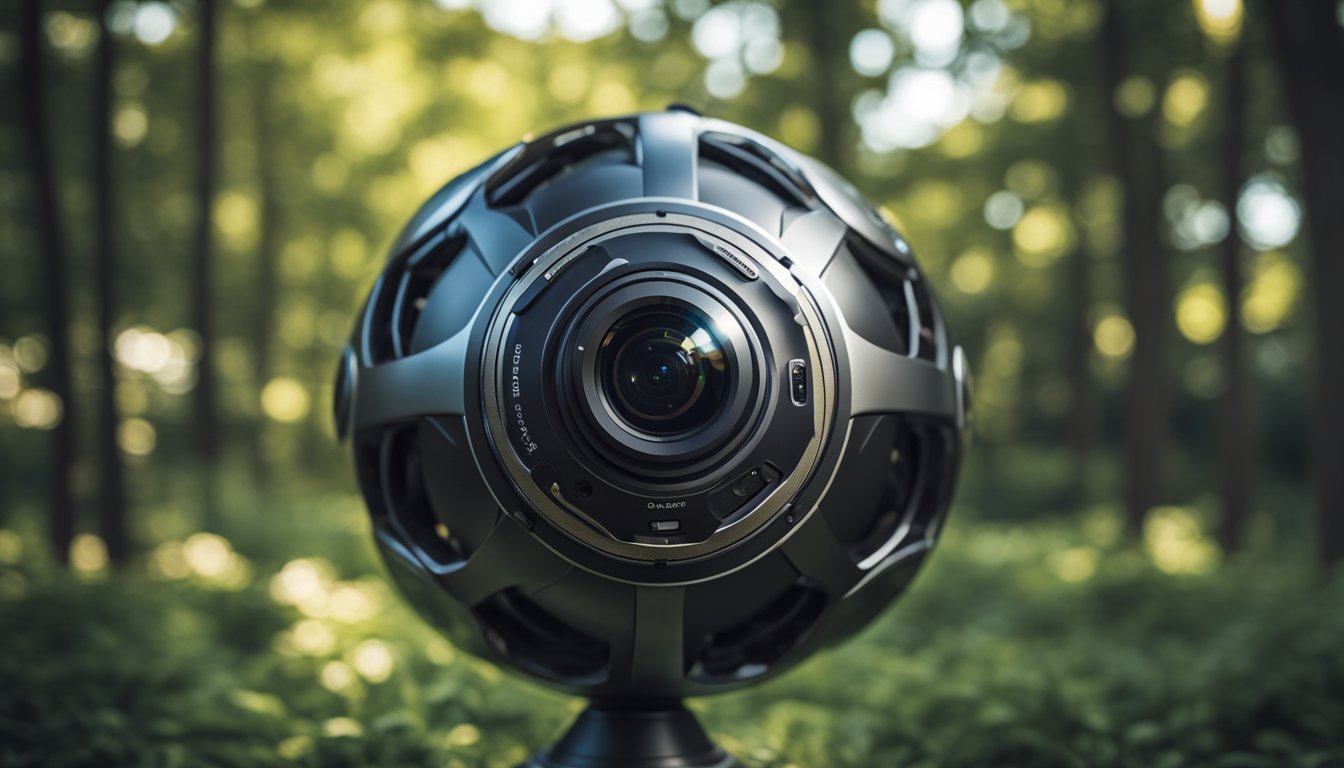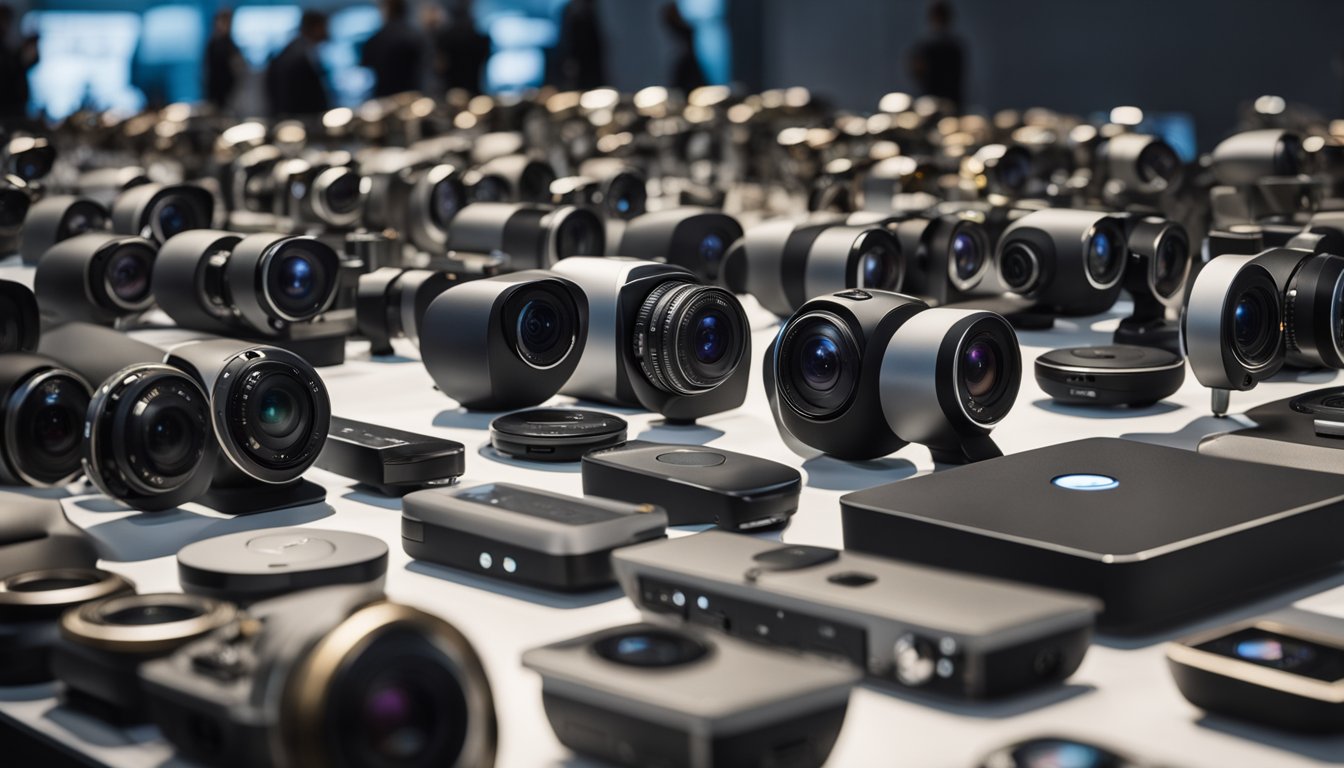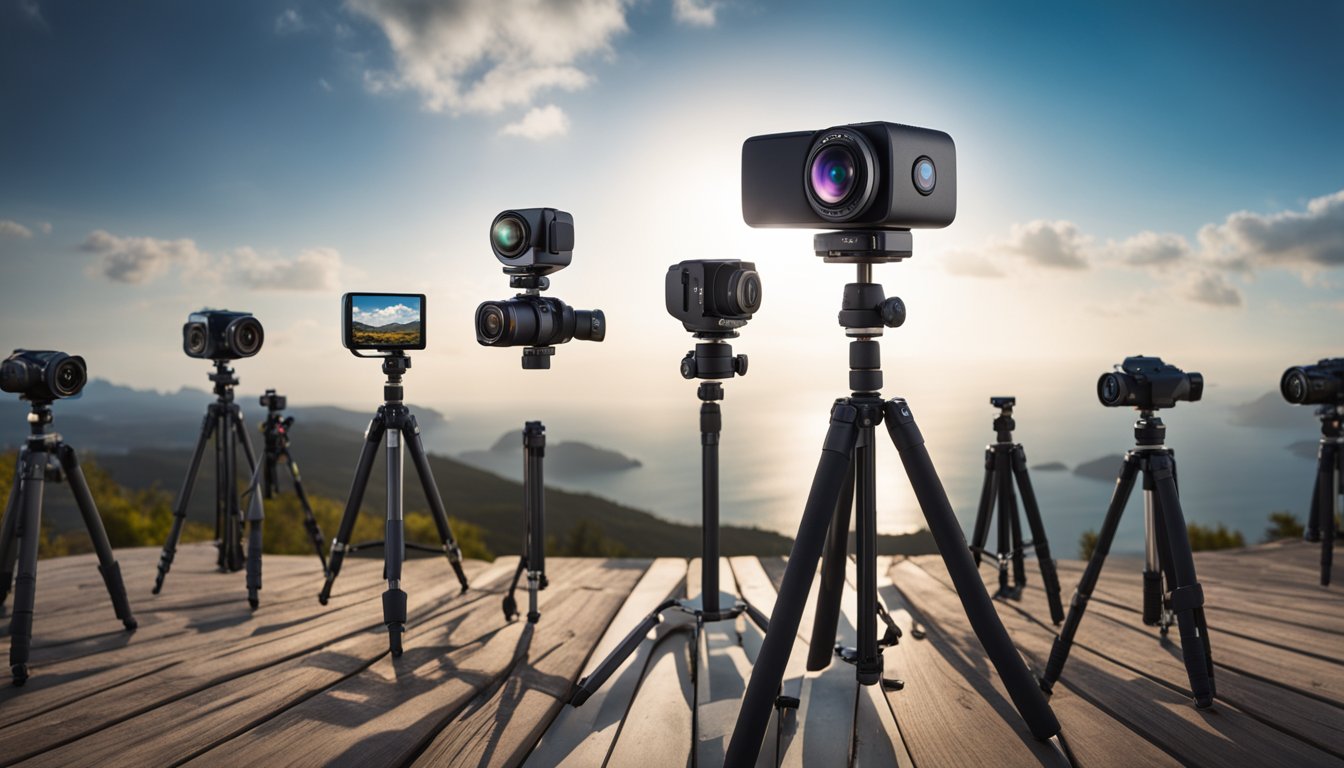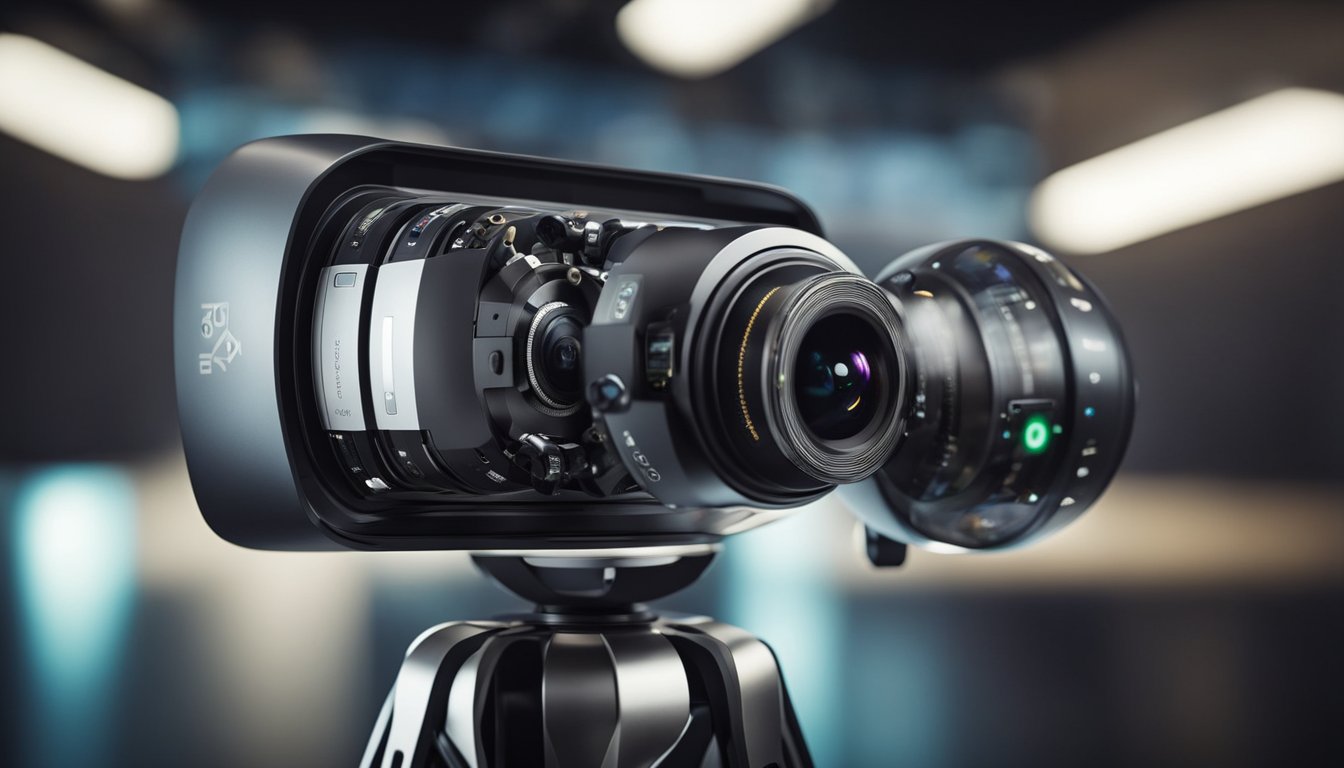A 360 camera is a device capable of capturing a full spherical view of the surroundings, creating immersive images and videos that put you at the center of the scene. Think of it as being inside a sphere, with a complete view in every direction, captured simultaneously. The design of such cameras varies, but they commonly feature multiple lenses that cover various angles, stitching together the captured content to create the final 360-degree output.

When you look at a 360 camera, you’ll notice it doesn’t resemble your traditional camera. Instead of a single lens pointing in one direction, 360 cameras are equipped with two or more lenses facing different directions. These cameras are crafted to be compact and portable, with a build designed to accommodate the intricate technology required to capture content from all angles. With the use of 360-degree cameras, you are able to produce content for a variety of platforms, from virtual reality experiences to interactive social media posts, that engage audiences in a novel and dynamic way.
Key Takeaways
- 360 cameras enable capturing of immersive spherical images and videos.
- They feature a distinct design with multiple lenses to cover all angles.
- The content produced is versatile for use in VR and interactive media.
Understanding 360 Cameras

When you encounter a 360 camera, you’re looking at a device specifically designed to capture a complete spherical view of its environment. This all-encompassing capture method creates immersive content that’s drastically different from what you’re used to with standard cameras.
Key Features of 360 Cameras
- Dual Lenses: Your 360 camera typically comes with two ultra-wide-angle lenses, often referred to as back-to-back fisheye lenses. Each lens is responsible for capturing a field of view that spans approximately 180 degrees.
- Frame and Field of View: The frame isn’t just what you see in front of you; with a 360 camera, it includes everything from the ground to the sky—no blind spots. This full-circle field of view allows for a uniquely comprehensive image or video.
How 360 Cameras Differ from Traditional Cameras
Unlike traditional cameras that capture a limited field of view—say, what’s directly in front of the lens—360 cameras offer an all-around view. Here are some specifics:
- Lenses: While a standard camera usually has one lens facing one direction, 360 cameras have dual lenses capturing every angle of the scene simultaneously.
- Sensors: The sensors in a 360 camera often work together to process information from both lenses, enabling the creation of a cohesive, spherical image.
By understanding the unique build and function of 360 cameras, you’ll be better equipped to utilize their complete range for capturing your world.
Different Types of 360 Cameras

In the world of 360-degree cameras, you have a variety of options to choose from, whether you’re just getting started or are a seasoned professional. These range from user-friendly, pocket-sized devices to sophisticated systems designed for the highest quality output.

Consumer-Friendly Options
Your journey into 360-degree photography can begin with consumer-friendly options, which are perfect if you’re a beginner or simply looking for ease of use. A popular choice in this category is the GoPro Max, known for its durability and versatility. Another option that blends accessibility with high-quality output is the Insta360 series, which include cameras that support 5.7K30 video and are equipped with features like Active HDR. These cameras are compact, easy to operate, and they often come with intuitive editing software to polish your 360 videos.
- GoPro Max: User-friendly interface, rugged design.
- Insta360: High resolution, advanced features like Active HDR.
Professional 360 Camera Solutions
If you’re a professional seeking top-tier image quality and control, consider professional 360 camera solutions. For instance, the Ricoh Theta series cameras have been a staple for pros who need portability without sacrificing the ability to capture detailed images and video. These professional units often include advanced optics, higher resolution sensors, and the ability to shoot in RAW format for maximum post-production flexibility.
- Ricoh Theta: Portability, high image quality for professionals.
- Professional features: Enhanced optics, RAW capture, high-resolution sensors.
360 Camera Design and Build

When choosing your 360 camera, you need to consider both the aesthetics and the resilience of the design. The right camera for you is both visually pleasing and durable enough to match your adventure.
Physical Design Elements
360 cameras often boast a slim form factor, making them highly portable and ideal for on-the-go shooting. Typically, these cameras feature dual lenses positioned back-to-back to capture a full 360-degree field of view. This design enables you to shoot immersive panoramas without any blind spots. Many models have an easy-to-grip surface or even a standard tripod mount to simplify setup.
- Lenses: Two wide-angle lenses are standard.
- Body: Often cylindrical or spherical for even coverage.
Durability and Water Resistance
Your 360 camera isn’t just about good looks; build quality plays a pivotal role in its longevity, especially if you’re an outdoor enthusiast. Many modern 360 cameras are designed with rugged exterior shells to withstand the occasional drop. When it comes to water, having a waterproof rating is essential for any underwater or bad weather shooting. Look for cameras with a clear indication of water resistance depth to ensure it fits your requirements.
- Material: Durable plastics and metals are common.
- Protection: Check for shockproof and waterproof ratings, such as IP67 or IP68.
Capturing 360-Degree Content
To effectively capture the world around you in its entirety, understanding the intricacies of a 360-degree camera’s functionality and mastering framing tactics can enhance your 360 videos and photos.
Understanding the Capture Process
How Does a 360 Car Camera Work? Unraveling the Technology Behind the Scenes »
When you use a 360 camera, you’re engaging in a process that utilises two fish-eye lenses. Each lens covers approximately 200 degrees which means their fields of view overlap. This allows for a comprehensive 360-degree coverage. In practice, once you’ve got your shot, the camera or an accompanying software stitches these images into a seamless panoramic view, transforming separate images into a single spherical photo or video.
Framing and Exposure Techniques
Framing with a 360 camera differs from traditional photography since you’re capturing every angle simultaneously. Pay attention to the placement of your camera: even though you can capture everything, central framing ensures even distribution of interest throughout the 360-degree footage. For exposure, be mindful that lighting conditions are even across the scene to prevent over or underexposed areas, which can be challenging outdoors. Understanding how to manipulate your camera’s settings can result in consistently well-lit 360 photos and videos.
Image and Video Quality Factors

When you’re exploring 360 cameras, you’ll find that image and video quality are greatly influenced by resolution and dynamic range as well as stabilization and image clarity.
Resolution and Dynamic Range
Resolution is a big player when it comes to the quality of your 360 videos. High resolution means more pixels and finer detail, leading to a clearer and more immersive experience. A camera that captures video at 8K allows for crispiness even when you zoom in or view on large displays. However, be aware that higher resolution can require more storage space and powerful processors to handle the data.
Dynamic range, on the other hand, refers to the camera’s ability to handle high contrast scenes. HDR (High Dynamic Range) is a feature that allows your camera to capture greater detail in both dark and bright areas, giving a more true-to-life appearance to your 360 content.
Stabilization and Image Clarity
Stabilization is key, especially considering the interactive nature of 360-degree content. You don’t want a little motion to cause a big disturbance in your immersive experience. Image stabilization technology compensates for camera shake, giving a smoother outcome that’s crucial for 360 videos.
Besides, a clear image is what makes a virtual tour or a panoramic shot stand out. A camera with good stabilization will also prevent blur, ensuring image clarity even when filming in motion. Look for cameras that promise good stabilization if you plan on moving around with your camera.
By weighing these factors—resolution, dynamic range, and stabilization—you’ll be able to pick a 360 camera that provides top-notch video quality for your immersive content.
Editing 360 Footage
When you’re delving into the world of 360-degree video, editing can be an exciting but complex task. Your aim is to stitch together footage to create a seamless immersive experience while perhaps reframing to highlight the most interesting parts of your panorama.
The 360 Video Editing Process
Your journey into editing 360 footage starts with stitching. This is the process of combining multiple images or videos from different camera lenses to form a single, cohesive 360-degree view. Accuracy here is vital to avoid visible stitch lines that can distract from the immersive experience. After stitching, you get to reframing parts of your video to guide the viewer’s attention. The editing process is not just about correction but also about creative control, allowing you to decide how your audience experiences the content.
Tools and Software for Editing
Your choice of editing tools strongly influences the outcome of your 360 video projects. For beginners, software like the Insta360 Studio is a good starting point as it’s designed specifically for 360 content. If you’re seeking more advanced options, Adobe Premiere Pro offers robust features and is explained in tutorials like How To Edit 360 Videos | Premiere Pro. For a comprehensive understanding, the Complete Guide to 360 Degree Video Editing by Pinnacle Studio can be an excellent resource. Remember, the right software not only allows stitching and reframing but also adds special effects and transitions tailor-made for 360 footage.
360 Cameras in Virtual Reality
360-degree cameras are key tools in bringing virtual reality experiences to life. They allow you to capture immersive footage that can then be relived through a VR headset.
VR Content Creation with 360 Cameras
When creating content for VR, your choice of a 360 camera can significantly affect the outcome. Cameras like these capture the world around you in all directions, resulting in a spherical video that puts the viewer at the center of the scene. The resolution is a pivotal factor here, as it dictates how crisp and lifelike your virtual reality content will appear. For instance, although a camera may advertise as 4K, in virtual reality, that translates to a lower resolution per eye because the image needs to encompass the entire 360-degree field.
Compatibility with VR Headsets
The content you create with your 360 camera is designed to be experienced through VR headsets. Different brands of cameras and headsets may have varying levels of compatibility, so it’s essential to ensure the footage from your camera works seamlessly with your intended VR headset. This doesn’t just mean it should display correctly, but the frame rate and file format are also critical for an immersive imaging experience. Some high-end 360 cameras are specifically designed to be compatible with a broad range of VR headsets, ensuring that the content you produce delivers a smooth and immersive virtual experience.
360 Cameras for Social Media and Sharing
360 cameras have revolutionized sharing on social media platforms like Instagram, Facebook, and YouTube, making it easier for you to create immersive experiences for your audience. With their unique capabilities, you can take your followers on virtual tours or live stream events in a way that conventional cameras just can’t match.
Live-Streaming Capabilities
Live-streaming with a 360 camera can bring your audience right into the heart of the action, as if they were standing beside you. Whether you’re streaming a concert on Facebook or a tutorial on YouTube, 360 live-streaming makes viewers feel more connected to your content. The best part? You don’t have to manually adjust the frame – your viewers can scroll around the video to see every angle, providing a comprehensive live experience.
Engaging Virtual Tours and Vlogs
When it comes to creating virtual tours or vlogs, a 360 camera can be your best friend. With platforms like Instagram and Facebook supporting 360 content, you can give your followers a “you are there” experience, whether you’re showcasing real estate or documenting your travels. Engage your viewers by crafting story-driven content, letting them explore every corner of the scene as they would in real life. The immersive nature of 360 videos makes your vlogs stand out, encouraging more interaction and shares across social media channels.
Storage and Connectivity Features
When you’re capturing life in 360 degrees, having ample storage and reliable connectivity options is key. Your 360 camera’s ability to store high-resolution content and seamlessly connect to your devices enhances your overall experience.
Memory and Storage Solutions
Most 360 cameras support SD card or microSD card formats which easily slide into your camera’s dedicated card slot. It’s important to choose a high-capacity card since 360-degree videos and images tend to be larger files. For instance, a card with at least 64GB can hold a substantial amount of 360 content, but you might want a 128GB microSD card for extended shooting sessions or higher resolution capturing.
Connecting to Devices and Networks
Your 360 camera isn’t just a standalone device; it’s designed to connect with your smartphone or computer for various functionalities. Wi-Fi is commonly built into modern 360 cameras, allowing you to transfer files wirelessly. In most cases, you can use a Wi-Fi connection to stream live 360-degree content straight to your social media platform. Additionally, many cameras have companion apps for smartphones, which lets you control the camera remotely and even edit your footage on the go.
360 Camera Accessories and Expansions
To get the most out of your 360 camera experience, consider both essential add-ons and the possibility of upgrades with additional equipment. Each type of accessory can enhance both the convenience of use and the quality of your captured footage.
Essential 360 Camera Add-ons
- Invisible Selfie Stick: The invisible selfie stick is a must-have for clear, unobstructed shots that give your content a floating camera effect.
- Battery Life: Extend your shooting sessions with extra batteries or a power bank, ensuring you don’t miss any action.
Upgrading with Additional Equipment
- Viewfinder: Some 360 cameras offer a viewfinder or ways to connect your smartphone to act as one, helping you frame your shots in real-time.
- Shot Lab: Look for software or in-built camera features like Shot Lab, which offers creative templates for interesting effects and editing.
- Accessories Kit: Consider kits that include a variety of accessories, from tripods to lens protectors, to fully equip your camera for any situation.
Choosing the Right 360 Camera
When you’re in the market for a 360 camera, it’s essential to focus on camera specifications and compare the top models available. Understanding the intricate details will ensure you purchase a camera that fits your needs perfectly.
Considering Camera Specifications
Your journey to finding the best 360 camera begins with evaluating camera specifications. Look for cameras that provide high resolution and sufficient image quality to meet your goals. For instance, if you are keen on capturing detailed images for professional work, cameras with higher megapixel counts like the Kandao QooCam should be on your radar.
Consider frame rates, especially if you’ll be capturing video; higher frame rates will give you smoother footage. Also, check for features such as image stabilization, HDR photo capabilities, and live-streaming functions that add versatility to your camera use.
Comparing Top 360 Camera Models
As you compare top models, keep in mind the specific use cases and the environments where you’ll be using the camera.
-
Insta360 One R: Recognized for its modularity, allowing you to flip between 360 shooting and standard 4K. An ideal pick if you want the flexibility to switch formats without carrying multiple cameras.
-
GoPro Max: Offers robust design and software that’s ideal for action shots and rugged use. GoPro’s reputation for durability means you can take this camera into challenging situations without worry.
-
Ricoh Theta SC2: A more budget-friendly option, great for those just getting started with 360 photography due to its ease of use and decent quality output.
-
Samsung Gear 360: Suitable for hobbyists who wish to experiment with 360-degree photography without investing too much. Good for simple, social media-friendly content.
Remember to read product reviews for these models to gauge user satisfaction and check for any recurrent issues. Moreover, comparing their prices and any bundled software will give you a complete picture of the value they offer.
Frequently Asked Questions
When exploring the capabilities and nuances of 360-degree cameras, you may have a few questions. Let’s dive into some common inquiries to help you understand their use and how they differ from other cameras.
Can 360 cameras be used effectively for vlogging?
Yes, 360 cameras offer a unique way for vloggers to create immersive content that engages viewers by showing a complete spherical view of the surroundings.
What are the cons of using 360-degree cameras?
While innovative, 360-degree cameras often require more time for editing and can produce large file sizes, making handling and storage a challenge. They also tend to have lower resolution compared to traditional flat frame cameras due to the image stretching over a larger area.
How do 360 cameras compare to traditional cameras?
Traditional cameras capture a limited field of view, while 360 cameras create a full spherical image or video, capturing every angle of the scene simultaneously.
What should you consider when purchasing a 360 camera?
Consider battery life, resolution, stitching capabilities, and whether the camera offers live-streaming or compatible editing software when looking to purchase a 360 camera.
How can one create 360 videos for YouTube?
Creating 360 videos for YouTube involves using a 360 camera to capture the video and then utilizing software to edit and convert the footage into a format compatible with YouTube’s 360-degree player.
What does a 360-degree photo capture compared to a standard photo?
A 360-degree photo captures an entire environment in every direction, offering a complete panoramic view, in contrast to a standard photo that generally captures a fixed, flat perspective limited to the direction the camera is pointed.







